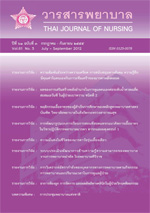การวิเคราะห์อัตรากำลังของบุคลากรทางการพยาบาล ตามกิจกรรมการพยาบาลและปริมาณเวลาในการดูแลผู้ป่วย
Main Article Content
Abstract
การวิจัยเชิงพรรณนานี้มีวัตถุประสงค์เพื่อ 1) สำรวจ ชั่วโมงความต้องการทางการพยาบาลต่อวันจำแนกตาม ประเภทผู้ป่วยสำหรับผู้ป่วยสามัญแผนกศัลยกรรม อายุรกรรม และสูติ-นรีเวชกรรม 2) วิเคราะห์ อัตรากำลังที่ต้องการของ บุคลากรทางการพยาบาลตามกิจกรรมการพยาบาลและ ปริมาณเวลาในการดูแลผู้ป่วย และ 3) หาสัดส่วนของ พยาบาลวิชาชีพต่อผู้ช่วยพยาบาล ใน เวรเช้า บ่าย และดึก ในหอผู้ป่วยสามัญ ในคณะแพทยศาสตร์วชิรพยาบาล มหาวิทยาลัยกรุงเทพมหานคร กลุ่มตัวอย่างเป็นพยาบาล วิชาชีพจำนวน 138 คน และผู้ช่วยพยาบาล 45 คน ใน คณะแพทยศาสตร์วชิรพยาบาล เครื่องมือวิจัย เป็นแบบ ประเมินประเภทผู้ป่วย และแบบวัดการปฏิบัติกิจกรรม การพยาบาล ผู้วิจัยและผู้ช่วยวิจัย 6 คน เก็บรวบรวมข้อมูล ใช้เวลา 30 วัน โดยการสังเกตและบันทึกเวลาที่ใช้ในการ ปฏิบัติกิจกรรมการพยาบาลโดยตรงและกิจกรรมอื่น และให้บุคลากรทางการพยาบาลบันทึกเวลาที่ใช้ในการปฏิบัติ กิจกรรมที่เกี่ยวข้องกับหน่วยงานและกิจกรรมส่วนบุคคลด้วย ตนเอง วิเคราะห์ข้อมูลโดยใช้สถิติบรรยายและคำนวณ หาอัตรากำลังโดยใช้สูตรของ Brown (1999)
ผลการวิจัยพบว่า จำนวนชั่วโมงความต้องการทาง การพยาบาลต่อวันต่อคนสำหรับผู้ป่วยสามัญประเภทที่ 1 ถึง 5 ของแผนกศัลยกรรม เท่ากับ 7.50, 8.23, 8.82, 9.63 และ 10.82 ชั่วโมงตามลำดับ ของแผนกอายุรกรรม เท่ากับ 7.52, 8.32, 9.19, 10.08 และ 11.22 ชั่วโมงตามลำดับ และของแผนกสูติ-นรีเวชกรรม เท่ากับ 2.68, 3.05, 3.32, 3.65 และ 4.00 ชั่วโมงตามลำดับ อัตรากำลังที่ต้องการของ พยาบาลวิชาชีพ และผู้ช่วยพยาบาล ของแผนกศัลยกรรม คือ 73 และ 24 คน แผนกอายุรกรรม คือ 77 และ 26 คน และแผนกสูติ-นรีเวชกรรม คือ 9 และ 5 คน ตามลำดับ สัดส่วนของพยาบาลวิชาชีพต่อผู้ช่วยพยาบาล เวรเช้า เวรบ่าย และเวรดึก ของหอผู้ป่วยสามัญแผนกศัลยกรรม เท่ากับ 29:10, 26:8 และ 18:6 แผนกอายุรกรรม เท่ากับ 31:10, 27:9 และ 19:7 ตามลำดับหรือประมาณ 3 ต่อ 1 และแผนกสูติ-นรีเวชกรรม เวรเช้า เท่ากับ 9:5 หรือ ประมาณ 2:1 ส่วนเวรบ่ายและเวรดึกไม่ได้ศึกษาเนื่องจาก มีผู้ป่วยจำนวนน้อยมาก
An analysis of nurse staffing according to nursing activities and time spent on patient care.
Thonggleeb, B.
The purposes of this research were: 1) to survey nursing hours per day according to patient classification 2) to determine the number of nursing personnel according to nursing activities and time spent on patients care and 3) to find the proportion of professional nurse and practical nurse in the day, evening, and night shifts in the surgical, medical, obstetrics and gynecology wards at the faculty of Medicine, Vajira Hospital, University of Bangkok Metropolis. The samples of 138 professional nurses and 45 practical nurses were selected. The research tools consisted of the patient classification evaluation, and the nursing activity and time spent assessment. In data collection, the researcher and 6 research assistants observed and recorded time spent in each nursing activities and indirect nursing activities in the surgical, medical, and obstetrics and gynecology patents. The nursing personnel recorded time spent in unit activities and personal activities by themselves. Descriptive statistics were used in data analysis and the Brown's formula was used in nursing staff calculation.
The results showed that the required nursing hours per day per case of patients in 1 to 5 categories in the surgical unit were 7.50, 8.23, 8.82, 9.63 and 10.82; in the medical patients were 7.52, 8.32, 9.19, 10.08 and 11.22; and in the obstetrics and gynecology unit were 2.68, 3.05, 3.32, 3.65 and 4.00 respectively. The required staffs of professional nurses and practical nurses were 73 and 24 in a surgical unit; 77 and 26 in a medical unit; and 9 and 5 in a obstetrics and gynecology unit. The proportion of professional nurses over practical nurses in the day, evening, and night shifts were 29:10, 26:8 and 18:6 in a surgical unit; 31:10, 27:9 and 19:7 in a medical unit, and 9:5 in the day shift in obstetrics and gynecology unit, but the evening and night shifts were excluded due to rare cases.

